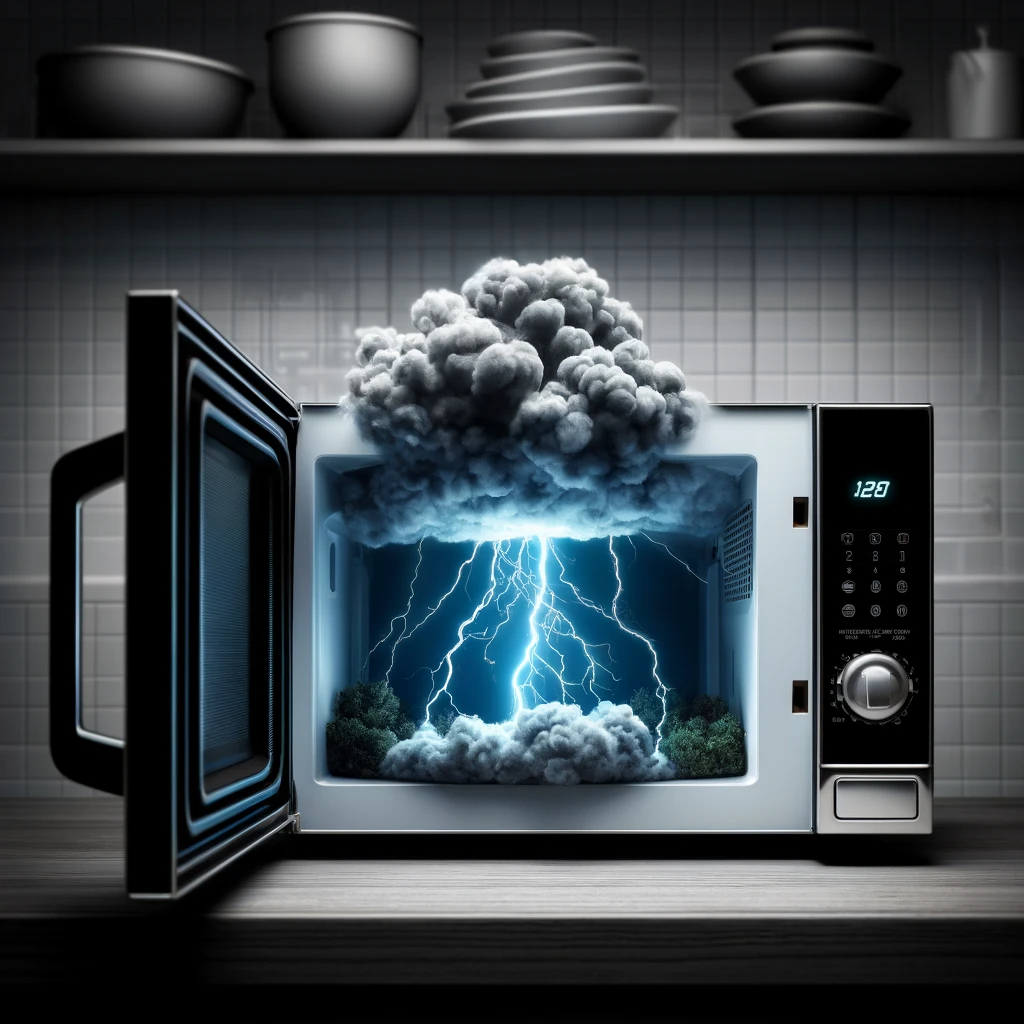Can you put metal in the microwave? This question might have crossed your mind as you quickly reheated leftovers or made a cup of instant coffee.
Microwaves are a staple in almost every kitchen, but their interaction with metal is shrouded in mystery and caution. You might wonder if it’s an absolute no-no, or if there are exceptions to the rule. Maybe you’ve heard some horror stories, or perhaps you’ve witnessed a few sparks fly yourself.
Before you decide to take a risk, it’s crucial to understand the science behind it. This article will demystify what really happens when metal meets microwave, ensuring you have all the information you need to keep your kitchen safe and your meals delicious. Let’s unravel the truth together and put your curiosity to rest. Are you ready to discover the facts and myths about microwaving metal? Keep reading!

Credit: www.whybuy.com.au
Microwave Technology Basics
Microwaves are a staple in modern kitchens. They heat food quickly and efficiently. But what exactly happens inside? Understanding the basics of microwave technology helps explain why metal is a concern. Let’s dive into how microwaves work and what makes them unique.
How Microwaves Heat Food
Microwaves use electromagnetic waves to heat food. These waves make water molecules in food vibrate. Vibration creates heat, cooking the food from the inside out. This process is different from traditional ovens, which heat food from the outside in.
Role Of Magnetrons
A key component in microwaves is the magnetron. It generates the microwaves that cook your food. This device converts electrical energy into microwave radiation. Without the magnetron, a microwave oven wouldn’t work.
Why Metal Reacts Differently
Metal reflects microwaves, unlike food. This reflection can cause sparks or fire. Metal disrupts the microwave’s energy flow. That’s why manufacturers advise against using metal inside.
Safety Features In Modern Microwaves
Modern microwaves include safety features. They prevent accidents and damage. For instance, many have sensors to detect excess heat. These sensors can shut off the microwave if needed.
Common Misconceptions
Some believe all metal is dangerous in microwaves. In reality, small amounts of certain metals are safe. For example, some manufacturers design microwave-safe foil. Always check guidelines before use.
Conclusion
Understanding microwave technology can prevent accidents. It’s crucial to follow manufacturer guidelines. This ensures safe and effective use.

Credit: www.youtube.com
Common Myths About Metal In Microwaves
Many people have questions about metal in microwaves. Some myths have made people nervous about using metal. Let’s explore these myths and find out the truth.
Myth 1: All Metal Causes Sparks
Not all metal causes sparks. Small, smooth pieces like spoons are usually safe. It’s the sharp edges that can cause problems.
Myth 2: Using Metal Will Break Your Microwave
This isn’t always true. Short bursts of metal exposure might not harm the microwave. But frequent use can wear it down.
Myth 3: Microwaving Metal Damages Food
Metal doesn’t damage food. It simply reflects microwave energy. This prevents food from heating evenly.
Myth 4: Metal Absorbs Microwave Energy
Metal doesn’t absorb microwaves. It reflects them. This can create uneven heating or sparks.
Myth 5: All Metal Is Banned In Microwaves
Some containers are microwave-safe and have metal lining. Always check the label for safety instructions.
Science Behind Metal Sparks
Have you ever seen sparks fly in a microwave? It might happen if you put metal inside. But why does this happen? The science behind these sparks can be fascinating.
When metal is placed in a microwave, it can create an electric field. This field is not the same as the one created by food or water. The metal can reflect the microwaves, causing them to bounce back. This can lead to sparks and even fires.
Understanding Microwave Energy
Microwaves use electromagnetic waves to heat food. These waves make water molecules in the food vibrate. This vibration creates heat, which cooks the food. Metal does not absorb microwaves the same way. Instead, it reflects them.
Role Of Electrons In Metals
Metals have free electrons that move easily. In a microwave, these electrons can move rapidly. This rapid movement can create sparks. The sharp edges of metal can amplify this effect.
Why Sparks Occur?
Sharp edges and points on metal cause sparks. These points concentrate the electric field. The concentrated field can ionize the air, leading to sparks. The sparks can damage the microwave or start a fire.
Safe Use Of Metal In Microwaves
Some metal can be safe to use in microwaves. Manufacturers might design special containers with metallic parts. They test these for safety. Always read instructions before using metal in a microwave.

Credit: blog.black-blum.com
Types Of Metal Safe For Microwaves
Using metal in a microwave often raises eyebrows. The fear of sparks and fires can deter many. Yet, not all metals are harmful in microwaves. Some can be used safely with precautions. Understanding which metals work can help avoid accidents and improve safety.
Aluminum Foil
Aluminum foil can be safe in microwaves. But, it must be used carefully. Use small amounts to cover parts of food. Make sure no foil touches the sides of the microwave. Smooth out any wrinkles to prevent sparks. Using it like this can help heat food evenly.
Metal Racks
Microwaves often come with metal racks. These are usually safe to use. They are designed specifically for microwave use. Make sure they are positioned correctly. Never let them touch the microwave’s walls. This avoids potential arcing and damage.
Metal Utensils
Most metal utensils are not safe in microwaves. Forks and spoons can cause sparks. Some newer utensils claim to be microwave-safe. Always check the manufacturer’s guidelines. When in doubt, choose microwave-safe alternatives.
Dangers Of Microwaving Metal
The microwave is a modern convenience that many of us rely on daily. But have you ever wondered why there’s such a fuss about not putting metal inside? It’s not just an old wives’ tale. The dangers of microwaving metal are real and can lead to serious consequences if ignored.
Fire Hazards
Metal reflects microwave energy instead of absorbing it. This reflection can cause sparks or even a fire inside your microwave. Imagine the panic of seeing flames where you expected a warm meal. It’s not just foil that poses a risk. Even a forgotten spoon can ignite a spark. Have you ever accidentally left a metal fork in your leftovers? Those few seconds can be enough to cause a mini fireworks show in your kitchen.
Microwave Damage
Besides the risk of fire, microwaving metal can damage your appliance. The sparks can harm the interior and may require costly repairs. In some cases, it might even render your microwave useless. You might think of it as just a quick heat-up job, but repeated exposure to metal can shorten the lifespan of your microwave significantly.
Next time you use your microwave, pause and consider what’s inside. Is it worth the risk? Keeping metal out can save you from unexpected dangers and maintain your microwave’s efficiency. If you’re unsure about certain items, check the manufacturer’s instructions. After all, it’s better to be safe than sorry.
Microwave-safe Alternatives
Microwaves are convenient for quick meals and reheating leftovers. Choosing the right container is crucial for safety and efficiency. Metal is not safe in microwaves. It can cause sparks and damage. Explore alternatives that work well and keep your microwave safe.
Glass Containers
Glass is a popular choice for microwave use. It’s durable and heat-resistant. Glass doesn’t react with food, ensuring flavors stay intact. Transparent glass lets you see your food while it heats. Use glass bowls or jars for soups and sauces.
Ceramic Dishes
Ceramic dishes are safe and stylish. They can handle high heat without cracking. Many ceramic plates come with lids, great for storing leftovers. They maintain food temperature well, making them ideal for dinners and desserts.
Silicone Products
Silicone is flexible and lightweight. It doesn’t absorb odors or flavors. Silicone molds are perfect for baking treats in the microwave. They’re easy to clean and store. Choose silicone covers for steaming vegetables and more.
Tips For Safe Microwave Use
Microwaves are essential in the kitchen, but they require safe use. Knowing what can go inside the microwave is vital. Metal is a common confusion. Understanding microwave safety ensures a longer appliance life and safety in the kitchen.
Understanding Microwave Principles
Microwaves use electromagnetic waves to heat food. Metal can cause sparks and fires. This is because metal reflects these waves, causing a dangerous buildup.
Use Microwave-safe Containers
Always choose containers labeled microwave-safe. Glass, ceramic, and certain plastics work well. Avoid using containers with metallic paint or decorations.
Avoid Overheating Foods
Overheating can lead to burns or explosions. Stir food midway to distribute heat evenly. Use shorter intervals to monitor progress.
Keep The Microwave Clean
Food residue can cause unpleasant smells and affect efficiency. Clean spills immediately. Use a damp cloth to wipe the interior regularly.
Follow Manufacturer Instructions
Every microwave has unique guidelines. Read the manual for specific safety tips. This helps prevent damage and ensures safe usage.
Monitor Cooking Progress
Don’t leave the microwave unattended during use. Watch for smoke or unusual noises. Stop and check food if anything seems off.
Frequently Asked Questions
Is It Safe To Put Metal In A Microwave?
Putting metal in a microwave is generally unsafe. It can cause sparks, fires, or damage to the appliance. Some microwaves may allow specific metal-safe items, but always check the manufacturer’s instructions. Avoid using metal to ensure safety and proper microwave function.
What Kind Of Metal Can Go In A Microwave-safe?
Generally, no metal is microwave-safe. Metal can cause sparks or fires in microwaves. Always use microwave-safe containers, such as glass or ceramic, for cooking. Check manufacturer guidelines for specific instructions on microwave-safe materials.
Can I Put A Metal Food Container In The Microwave?
Do not use metal containers in the microwave. Metal can cause sparks, fire, and damage to the appliance. Always opt for microwave-safe glass or ceramic containers for heating food safely. Ensure containers are labeled as microwave-safe to avoid hazards.
Can Metal Mess Up A Microwave?
Metal can cause sparks and damage in a microwave. It reflects microwaves, potentially leading to fires. Use microwave-safe containers to avoid hazards. Always check the manufacturer’s instructions before using any metal objects in a microwave. Proper usage ensures safety and prevents accidents.
Final Words
Microwaving metal is risky. It can spark and cause damage. Always check your microwave’s manual before using metal. Some metals are safe, but most aren’t. Avoid putting foil or utensils inside. Safety comes first in the kitchen. Consider using microwave-safe containers instead.
These are often glass or ceramic. They heat food evenly without risk. Keep your kitchen safe with smart choices. Understanding these tips helps prevent accidents. Always be cautious with what you microwave. Remember, it’s better to be safe than sorry.
Happy cooking!

Leave a Reply